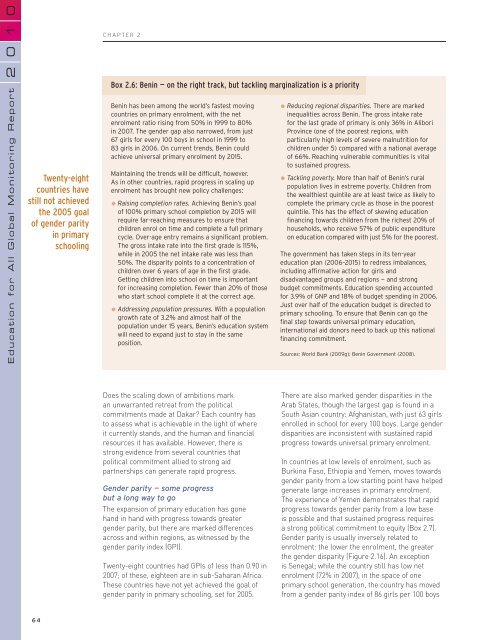Chapter 2. Progress towards the EFA goals - Unesco
Chapter 2. Progress towards the EFA goals - Unesco
Chapter 2. Progress towards the EFA goals - Unesco
You also want an ePaper? Increase the reach of your titles
YUMPU automatically turns print PDFs into web optimized ePapers that Google loves.
0<br />
0<br />
1<br />
CHAPTER 2<br />
2<br />
Education for All Global Monitoring Report<br />
Twenty-eight<br />
countries have<br />
still not achieved<br />
<strong>the</strong> 2005 goal<br />
of gender parity<br />
in primary<br />
schooling<br />
Box <strong>2.</strong>6: Benin — on <strong>the</strong> right track, but tackling marginalization is a priority<br />
Benin has been among <strong>the</strong> world’s fastest moving<br />
countries on primary enrolment, with <strong>the</strong> net<br />
enrolment ratio rising from 50% in 1999 to 80%<br />
in 2007. The gender gap also narrowed, from just<br />
67 girls for every 100 boys in school in 1999 to<br />
83 girls in 2006. On current trends, Benin could<br />
achieve universal primary enrolment by 2015.<br />
Maintaining <strong>the</strong> trends will be difficult, however.<br />
As in o<strong>the</strong>r countries, rapid progress in scaling up<br />
enrolment has brought new policy challenges:<br />
Raising completion rates. Achieving Benin’s goal<br />
of 100% primary school completion by 2015 will<br />
require far-reaching measures to ensure that<br />
children enrol on time and complete a full primary<br />
cycle. Over-age entry remains a significant problem.<br />
The gross intake rate into <strong>the</strong> first grade is 115%,<br />
while in 2005 <strong>the</strong> net intake rate was less than<br />
50%. The disparity points to a concentration of<br />
children over 6 years of age in <strong>the</strong> first grade.<br />
Getting children into school on time is important<br />
for increasing completion. Fewer than 20% of those<br />
who start school complete it at <strong>the</strong> correct age.<br />
Addressing population pressures. With a population<br />
growth rate of 3.2% and almost half of <strong>the</strong><br />
population under 15 years, Benin’s education system<br />
will need to expand just to stay in <strong>the</strong> same<br />
position.<br />
Reducing regional disparities. There are marked<br />
inequalities across Benin. The gross intake rate<br />
for <strong>the</strong> last grade of primary is only 36% in Alibori<br />
Province (one of <strong>the</strong> poorest regions, with<br />
particularly high levels of severe malnutrition for<br />
children under 5) compared with a national average<br />
of 66%. Reaching vulnerable communities is vital<br />
to sustained progress.<br />
Tackling poverty. More than half of Benin’s rural<br />
population lives in extreme poverty. Children from<br />
<strong>the</strong> wealthiest quintile are at least twice as likely to<br />
complete <strong>the</strong> primary cycle as those in <strong>the</strong> poorest<br />
quintile. This has <strong>the</strong> effect of skewing education<br />
financing <strong>towards</strong> children from <strong>the</strong> richest 20% of<br />
households, who receive 57% of public expenditure<br />
on education compared with just 5% for <strong>the</strong> poorest.<br />
The government has taken steps in its ten-year<br />
education plan (2006–2015) to redress imbalances,<br />
including affirmative action for girls and<br />
disadvantaged groups and regions — and strong<br />
budget commitments. Education spending accounted<br />
for 3.9% of GNP and 18% of budget spending in 2006.<br />
Just over half of <strong>the</strong> education budget is directed to<br />
primary schooling. To ensure that Benin can go <strong>the</strong><br />
final step <strong>towards</strong> universal primary education,<br />
international aid donors need to back up this national<br />
financing commitment.<br />
Sources: World Bank (2009g); Benin Government (2008).<br />
Does <strong>the</strong> scaling down of ambitions mark<br />
an unwarranted retreat from <strong>the</strong> political<br />
commitments made at Dakar? Each country has<br />
to assess what is achievable in <strong>the</strong> light of where<br />
it currently stands, and <strong>the</strong> human and financial<br />
resources it has available. However, <strong>the</strong>re is<br />
strong evidence from several countries that<br />
political commitment allied to strong aid<br />
partnerships can generate rapid progress.<br />
Gender parity — some progress<br />
but a long way to go<br />
The expansion of primary education has gone<br />
hand in hand with progress <strong>towards</strong> greater<br />
gender parity, but <strong>the</strong>re are marked differences<br />
across and within regions, as witnessed by <strong>the</strong><br />
gender parity index (GPI).<br />
Twenty-eight countries had GPIs of less than 0.90 in<br />
2007; of <strong>the</strong>se, eighteen are in sub-Saharan Africa.<br />
These countries have not yet achieved <strong>the</strong> goal of<br />
gender parity in primary schooling, set for 2005.<br />
There are also marked gender disparities in <strong>the</strong><br />
Arab States, though <strong>the</strong> largest gap is found in a<br />
South Asian country: Afghanistan, with just 63 girls<br />
enrolled in school for every 100 boys. Large gender<br />
disparities are inconsistent with sustained rapid<br />
progress <strong>towards</strong> universal primary enrolment.<br />
In countries at low levels of enrolment, such as<br />
Burkina Faso, Ethiopia and Yemen, moves <strong>towards</strong><br />
gender parity from a low starting point have helped<br />
generate large increases in primary enrolment.<br />
The experience of Yemen demonstrates that rapid<br />
progress <strong>towards</strong> gender parity from a low base<br />
is possible and that sustained progress requires<br />
a strong political commitment to equity (Box <strong>2.</strong>7).<br />
Gender parity is usually inversely related to<br />
enrolment: <strong>the</strong> lower <strong>the</strong> enrolment, <strong>the</strong> greater<br />
<strong>the</strong> gender disparity (Figure <strong>2.</strong>16). An exception<br />
is Senegal; while <strong>the</strong> country still has low net<br />
enrolment (72% in 2007), in <strong>the</strong> space of one<br />
primary school generation, <strong>the</strong> country has moved<br />
from a gender parity index of 86 girls per 100 boys<br />
64
















